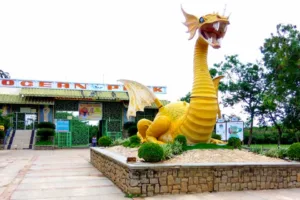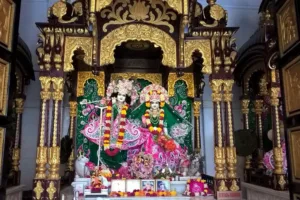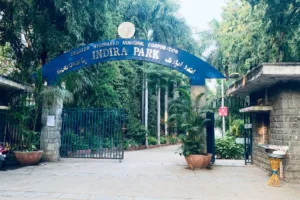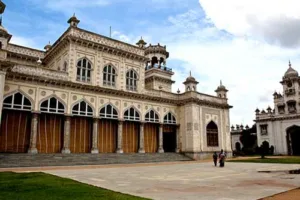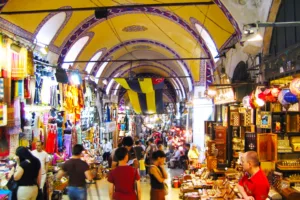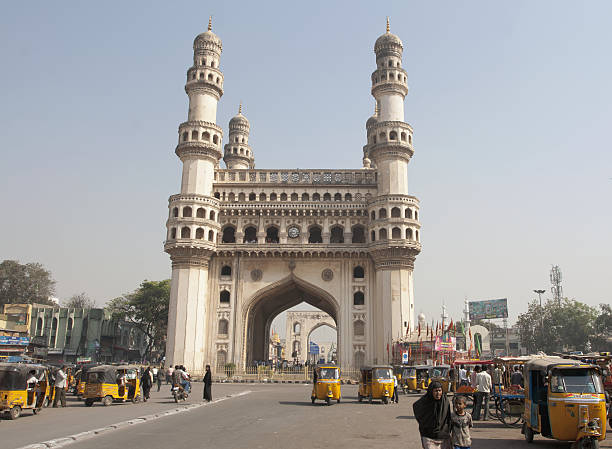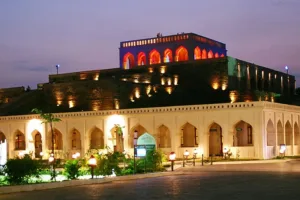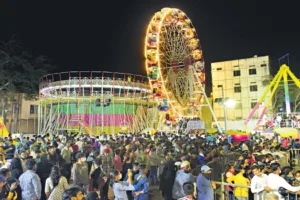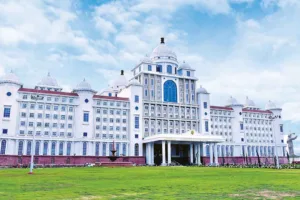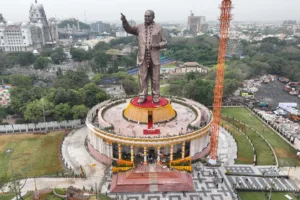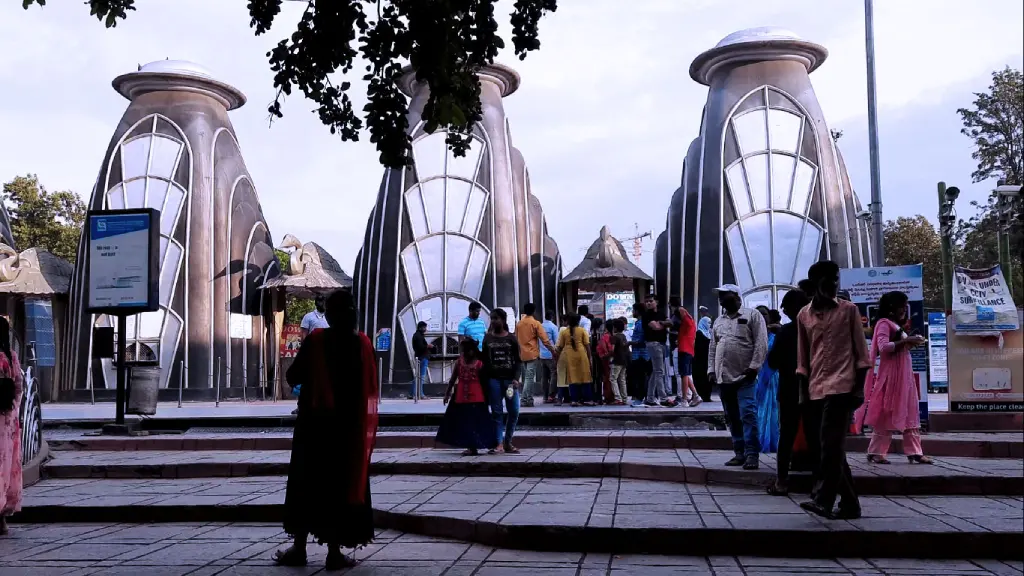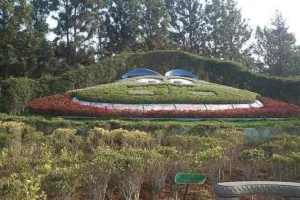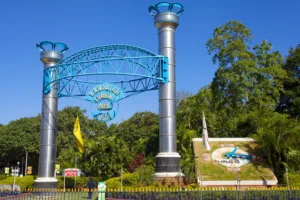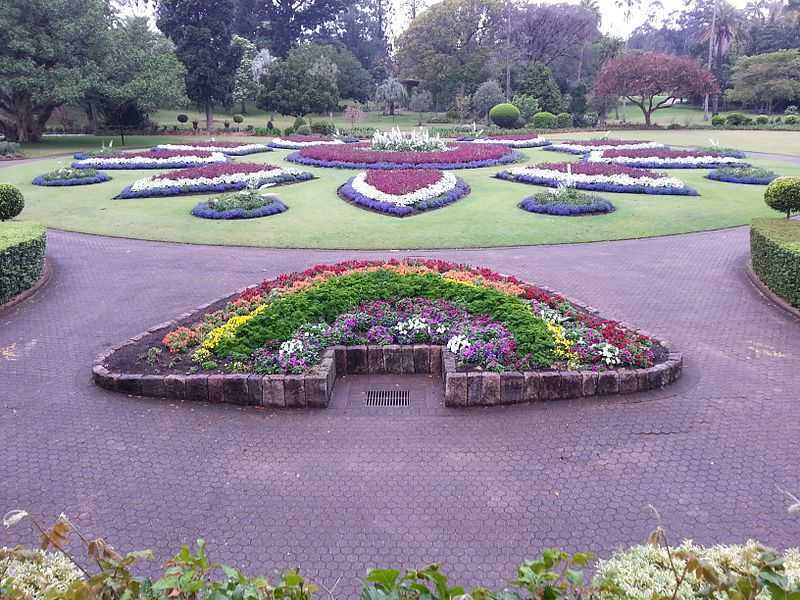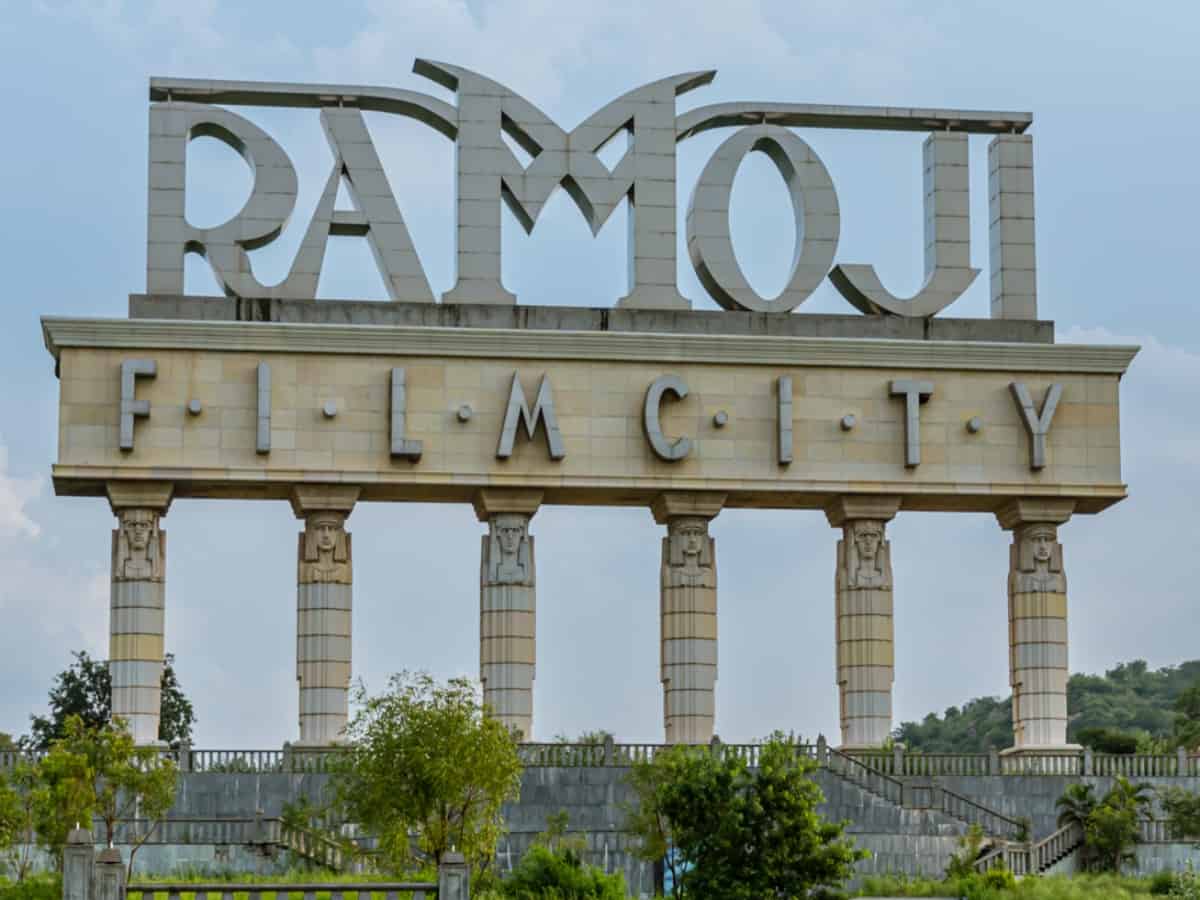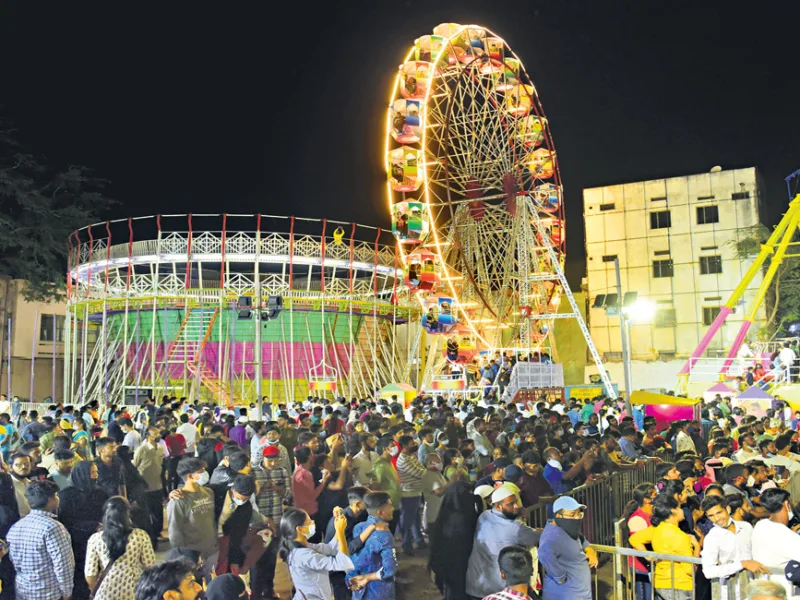List of famous Temples in India: State wise
Andhra Pradesh
Andhra Pradesh, situated in southern India, is renowned for its rich cultural heritage and spirituality. The state boasts a diverse range of landscapes, from lush forests to coastal plains. Famous Temples
Tirumala Venkateswara Temple: Located in Tirumala, this temple dedicated to Lord Venkateswara is one of the most visited pilgrimage sites globally. It is known for its stunning architecture and spiritual significance.
Kanaka Durga Temple (Vijayawada): Perched on the Indrakeeladri Hill in Vijayawada, this temple is dedicated to Goddess Kanaka Durga, drawing devotees with its picturesque location and religious fervor.
Simhachalam Temple (Visakhapatnam): Situated on the Simhachalam hill, this temple is dedicated to Lord Narasimha, an incarnation of Lord Vishnu. The temple’s intricate architecture and serene ambiance make it a must-visit.
Arunachal Pradesh
Arunachal Pradesh, nestled in the northeastern part of India, is known for its pristine natural beauty and spiritual tranquility. Famous Temple
Tawang Monastery: This Buddhist monastery, located in Tawang, is not only a place of worship but also offers breathtaking views of the Himalayan landscape. It is one of the largest monasteries in India and a symbol of spiritual serenity.
Assam
Assam, a state in Northeast India, is famous for its lush landscapes and vibrant cultural heritage. Famous Temples
Kamakhya Temple (Guwahati): Situated atop the Nilachal Hill in Guwahati, this Shakti Peetha temple is dedicated to Goddess Kamakhya. It is a center of devotion and cultural significance.
Umananda Temple: Located on Peacock Island in the Brahmaputra River, this temple is dedicated to Lord Shiva. It provides a unique pilgrimage experience amidst the scenic river surroundings.
Bihar
Bihar, known as the “Land of Enlightenment,” is steeped in spiritual history and cultural significance. Famous Temples
Mahabodhi Temple (Bodh Gaya): This temple marks the spot where Siddhartha Gautama attained enlightenment and became the Buddha. It is a UNESCO World Heritage Site and a place of profound spirituality.
Vishnupad Temple (Gaya): Dedicated to Lord Vishnu, this temple in Gaya holds immense religious importance for Hindus.
Patan Devi Temple (Patna): A significant temple dedicated to Goddess Patan Devi, it’s known for its historical and religious significance.
Chhattisgarh
Chhattisgarh, located in central India, is known for its tribal culture and deep spirituality. Famous Temples
Bambleshwari Temple (Dongargarh): Perched atop a hill in Dongargarh, this temple is dedicated to Goddess Bambleshwari and offers stunning panoramic views.
Chitrakoot Temple: This temple is known for its historical and spiritual significance, attracting devotees seeking divine blessings.
Danteshwari Temple (Dantewada): Dedicated to Goddess Danteshwari, this temple reflects the state’s rich heritage and devotion.
Goa
Goa, renowned for its beaches and vibrant nightlife, also has a unique blend of Hindu and Portuguese influences. Famous Temples
Shanta Durga Temple: Located in Kavlem, this temple is dedicated to Goddess Shanta Durga. It showcases Goa’s fusion of culture and spirituality.
Mangeshi Temple: Situated in Priol, this temple dedicated to Lord Mangesh is another architectural gem that highlights Goa’s spiritual side amidst its coastal charm.
Gujarat
Gujarat, located in western India, is a state known for its vibrant culture and historical significance. Famous Temples
Somnath Temple: Situated on the shores of the Arabian Sea in Prabhas Patan, this temple is dedicated to Lord Shiva and is one of the twelve Jyotirlinga shrines. It holds immense religious importance.
Dwarkadhish Temple (Dwarka): Dedicated to Lord Krishna, this temple in Dwarka is a major pilgrimage site for Hindus. It is believed to be the ancient kingdom of Lord Krishna.
Ambaji Temple (Ambaji): This temple dedicated to Goddess Ambaji is a revered Shakti Peetha and a center of devotion for devotees.
Haryana
Haryana, situated in northern India, is a state renowned for its rich history and diverse culture. Famous Temples
Sheetla Mata Temple (Gurugram): This temple is dedicated to Sheetla Mata, the goddess of smallpox. It is a significant pilgrimage site and is particularly crowded during the Sheetla Ashtami fair.
Bhuteshwar Temple (Yamunanagar): Dedicated to Lord Shiva, this ancient temple is known for its intricate architecture and serene surroundings. It’s a place of religious importance and historical charm.
Jyotisar: This is believed to be the spot where Lord Krishna delivered the Bhagavad Gita to Arjuna during the Mahabharata. It has a sacred banyan tree and a serene atmosphere.
Pataleshwar Cave Temple (Ambala): This ancient cave temple is dedicated to Lord Shiva and is carved out of a single rock. It’s known for its unique architecture and religious significance.
Sannihit Sarovar (Kurukshetra): This sacred sarovar (pond) is believed to be the meeting point of seven holy rivers. It is mentioned in Hindu scriptures and is associated with the Mahabharata.
Himachal Pradesh
A state nestled in the Himalayas, is renowned for its natural beauty and religious significance. It boasts several famous temples dedicated to various deities. Here are some of the most well-known temples in Himachal Pradesh
Hadimba Devi Temple (Manali): Located in Manali, this temple is dedicated to Hadimba Devi, the wife of Bhima from the Mahabharata. It is known for its distinctive architecture and beautiful setting amidst cedar forests.
Jwala Ji Temple (Kangra): This temple is dedicated to Goddess Jwala Ji, the deity of flames. It is one of the 51 Shakti Peethas and is known for a continuously burning sacred flame.
Chintpurni Temple (Una): Also known as Chhinnamastika Devi Temple, it is dedicated to Goddess Chintpurni, one of the forms of Goddess Shakti. Devotees visit to seek her blessings.
Naina Devi Temple (Bilaspur): Situated on a hill, this temple is dedicated to Goddess Naina Devi. It offers panoramic views of the surrounding area and the Govind Sagar Lake.
Baijnath Temple (Kangra): Dedicated to Lord Shiva, this ancient temple is known for its intricate stone carvings and is an important pilgrimage site for Hindus.
Chamunda Devi Temple (Kangra): This temple is dedicated to Goddess Chamunda, a form of Goddess Durga. It is located in a picturesque setting and is visited by devotees and tourists.
Bhimakali Temple (Sarahan): Situated in Sarahan, this temple is dedicated to Goddess Bhimakali, an incarnation of Goddess Durga. It is known for its unique architecture and religious significance.
Laxmi Narayan Temple (Chamba): Also known as the Chamba Temple, it is dedicated to Lord Vishnu and is an example of the Shikhara style of temple architecture.
Masrur Rock Cut Temple (Kangra): This is a complex of rock-cut temples dedicated to Lord Shiva. The temple complex is known for its ancient carvings and rock-cut architecture.
Bijli Mahadev Temple (Kullu): This temple is dedicated to Lord Shiva and is known for the 60-foot high lightning rod that attracts lightning during thunderstorms.
These temples in Himachal Pradesh not only hold religious significance but also showcase the state’s rich cultural heritage and stunning landscapes. They are visited by devotees and travelers seeking spiritual solace and natural beauty.
Jharkhand
Jharkhand, located in eastern India, is a state celebrated for its natural beauty, tribal culture, and historical significance. Famous Sites
Jagannath Temple (Ranchi): This temple is a significant religious landmark in the capital city of Ranchi, dedicated to Lord Jagannath, Lord Balabhadra, and Devi Subhadra. It’s known for its annual Rath Yatra (chariot procession) that attracts devotees.
Baidyanath Jyotirlinga Temple (Deoghar): One of the twelve Jyotirlinga shrines, this temple is devoted to Lord Shiva. It’s a place of immense religious importance and draws thousands of pilgrims annually.
Parasnath Temple (Giridih): Situated on Parasnath Hill, this temple is a sacred Jain pilgrimage site. It’s believed to be the spot where Lord Parshvanath, the 23rd Tirthankara, attained nirvana.
Hundru Falls (Ranchi): Known for its breathtaking beauty, Hundru Falls is one of the highest waterfalls in India. It’s a popular destination for nature enthusiasts and a great place for picnics.
Betla National Park: Located in the Palamau district, this national park is known for its rich biodiversity and is home to various species of flora and fauna, including tigers, elephants, and sloth bears.
Netarhat: Often referred to as the ‘Queen of Chotanagpur,’ Netarhat is a hill station known for its pleasant climate and stunning sunset views. It’s a serene escape from the hustle and bustle of city life.
Jonha Falls (Ranchi): Also known as Gautamdhara, this waterfall is surrounded by lush greenery and is a tranquil spot for relaxation and picnics.
Hazaribagh National Park: This park is famous for its population of leopards and various species of deer. It offers opportunities for wildlife enthusiasts and birdwatchers.
Rajrappa Temple (Ramgarh): Situated on the confluence of the rivers Damodar and Bhairavi, this temple complex is dedicated to the goddess Chhinnamastika. It’s a significant religious site.
Ranchi Hill: This hill is home to several attractions, including the Pahari Temple and the Ranchi Lake. It offers panoramic views of the city and is a popular tourist spot.
Jharkhand’s combination of natural wonders and cultural heritage makes it a compelling destination for travelers looking to explore the diversity of India’s eastern region.
Karnataka
Karnataka, in the southwestern part of India, is known for its diverse landscapes and historical sites. Famous Temples
Virupaksha Temple (Hampi): This temple dedicated to Lord Shiva is part of the UNESCO World Heritage Site of Hampi, which showcases the ruins of the Vijayanagara Empire.
Murudeshwar Temple: Located on the coast of the Arabian Sea, this temple is famous for its towering statue of Lord Shiva and its picturesque seaside location.
Kollur Mookambika Temple: Dedicated to Goddess Mookambika, this temple in Kollur is one of the seven Mookambika temples in Karnataka and a significant pilgrimage site for devotees.
These descriptions highlight the cultural, historical, and spiritual significance of each state, offering a glimpse into the diverse and fascinating world of India’s temples and pilgrimage destinations.
Kerala
A southwestern state in India known as “God’s Own Country,” is renowned for its lush landscapes and vibrant culture. It’s also home to several famous temples, reflecting the state’s rich religious traditions. Here are some of the most well-known temples in Kerala
Sree Padmanabhaswamy Temple (Thiruvananthapuram): Dedicated to Lord Padmanabhaswamy (a form of Lord Vishnu), this temple is famous for its opulent treasures, including the world’s richest temple vaults. It’s a significant pilgrimage site for Hindus.
Guruvayur Temple (Guruvayur): This temple, dedicated to Lord Krishna, is one of the most important pilgrimage centers for Hindus in Kerala. It’s known for its strict dress code and Elephant Sanctuary.
Sabarimala Temple (Pathanamthitta): Nestled in the Western Ghats, this temple is dedicated to Lord Ayyappa and is famous for its annual pilgrimage, the Mandala Makaravilakku. It attracts millions of devotees each year.
Attukal Bhagavathy Temple (Thiruvananthapuram): Known as the “Sabarimala of Women,” this temple is dedicated to Goddess Bhagavathy. It hosts the Pongala Festival, where millions of women prepare a special offering.
Ambalappuzha Sri Krishna Temple (Alappuzha): Dedicated to Lord Krishna, this temple is known for its daily offering of Pal Payasam, a sweet milk pudding, to the deity.
Padanilam Parabrahma Temple (Alappuzha): This temple, dedicated to Lord Parabrahma, is famous for its annual Padanilam Sivarathri Festival.
Vadakkunnathan Temple (Thrissur): Dedicated to Lord Shiva, this temple is known for its unique Koothambalam and Thrissur Pooram festival, one of the largest temple festivals in Kerala.
Ettumanoor Mahadeva Temple (Kottayam): This temple is dedicated to Lord Shiva and is known for its beautiful murals, exceptional wood carvings, and the annual Ettumanoor Shivaratri Festival.
Chottanikkara Devi Temple (Ernakulam): Dedicated to Goddess Bhagavathy, this temple is famous for its exorcism rituals and the annual Chottanikkara Makam Festival.
Koodalmanikyam Temple (Thrissur): Dedicated to Lord Bharatha, the younger brother of Lord Rama, this temple is known for its unique architecture and the Bharatha Temple Festival.
These temples in Kerala are not only places of worship but also architectural marvels and cultural landmarks. They play a significant role in the lives of the people of Kerala and attract visitors from around the world interested in the state’s religious and cultural heritage.
Madhya Pradesh
Madhya Pradesh, often referred to as the “Heart of India,” is known for its rich history and architectural wonders. Famous Temples
Khajuraho Temples: These UNESCO World Heritage Sites are known for their intricate erotic sculptures and stunning architecture. The temples represent a unique blend of religion and art.
Ujjain: This ancient city is home to the Mahakaleshwar Jyotirlinga Temple, dedicated to Lord Shiva. It is one of the twelve Jyotirlingas in India.
Omkareshwar Temple (Omkareshwar Island): Situated on an island in the Narmada River, this temple is dedicated to Lord Shiva and is one of the holiest shrines in India.
Maharashtra
Maharashtra, situated in western India, is a state renowned for its rich history, cultural heritage, and economic significance. Famous Temples
Siddhivinayak Temple (Mumbai): This iconic temple in Mumbai is dedicated to Lord Ganesha, the remover of obstacles. It’s a major pilgrimage site and a symbol of devotion for countless devotees.
Shirdi Sai Baba Temple (Shirdi): Devoted to the revered saint Sai Baba, this temple in Shirdi is a major pilgrimage site, drawing devotees from all over the world seeking spiritual solace.
Bhimashankar Temple: Located near Pune, this temple is one of the twelve Jyotirlinga shrines of Lord Shiva. It’s set in the scenic Sahyadri Mountains and is known for its spiritual significance and natural beauty.
Trimbakeshwar Temple: Situated in Trimbak, this ancient temple is another of the twelve Jyotirlinga shrines. It’s dedicated to Lord Shiva and is known for its religious and architectural importance.
Pandharpur Vithoba Temple: Situated in Pandharpur, this temple is dedicated to Lord Vithoba, an incarnation of Lord Krishna. It’s a revered pilgrimage site, particularly during the Ashadi Ekadashi festival.
Grishneshwar Temple: Located near Ellora, this temple is the twelfth and final Jyotirlinga shrine. It’s a place of great religious significance and is surrounded by the stunning Ellora Caves.
Mahalakshmi Temple (Kolhapur): Dedicated to Goddess Mahalakshmi, this temple in Kolhapur is known for its unique black stone idol of the goddess and is an important pilgrimage site for devotees.
Babulnath Temple (Mumbai): This ancient temple in Mumbai is dedicated to Lord Shiva. It’s perched on a small hill and offers panoramic views of the city.
Ghrishneshwar Temple (Ellora): Located near the Ellora Caves, this temple is dedicated to Lord Shiva and is an integral part of the region’s cultural and religious heritage.
Mumbadevi Temple (Mumbai): This temple is dedicated to Mumbadevi, the city’s patron goddess, and is believed to be the origin of the name “Mumbai.” It’s a symbol of Mumbai’s deep-rooted history.
Manipur
A northeastern state of India, is known for its stunning natural beauty and rich cultural heritage. While Manipur is predominantly a state with indigenous tribal beliefs and practices, there are a few Hindu temples that hold significance in the region. Here are a couple of famous temples in Manipur
Shree Govindajee Temple (Imphal): This temple is one of the most important Hindu temples in Manipur and is dedicated to Lord Krishna. It was built during the reign of King Charairongba in the 18th century and is known for its intricate architecture, which combines both Hindu and Manipuri styles. The temple complex also includes an attractive garden and a large pond.
Shree Radha Raman Temple (Imphal): This temple is another significant Hindu shrine in Imphal, dedicated to Lord Krishna and Radha. It’s a place of devotion for the Manipuri Vaishnavites and showcases beautiful idols of the deities. The temple is often visited by pilgrims and tourists alike.
It’s important to note that while these Hindu temples are prominent in Manipur, the state’s dominant religious and cultural practices are rooted in indigenous traditions, including Sanamahism and various tribal belief systems. Manipur is known for its unique and diverse cultural heritage, including traditional dance forms like Manipuri dance and martial arts like Thang-Ta.
Meghalaya
A state in northeastern India, is primarily inhabited by indigenous tribal communities who follow their own traditional belief systems. As a result, you won’t find many Hindu temples in Meghalaya as you would in other parts of India. However, there are a few temples and places of worship that have gained recognition in the state
Mahadev Khola Dham (Khliehriat): This temple, located in Khliehriat, is dedicated to Lord Shiva. It’s one of the few Hindu temples in Meghalaya and is known for its religious significance among the local Hindu population. The temple hosts various religious ceremonies and festivals throughout the year.
Matri Mandir (Shillong): Matri Mandir, situated in the capital city of Shillong, is a temple dedicated to the goddess Kali. It’s a place of worship for devotees of the goddess and is known for its colorful and ornate architecture.
St. Mary’s Cathedral (Shillong): While not a traditional Hindu temple, St. Mary’s Cathedral is an iconic religious structure in Shillong. It’s the seat of the Roman Catholic Archdiocese of Shillong and is known for its beautiful architecture and serene ambiance.
All Saints Church (Shillong): Another significant Christian place of worship in Shillong, All Saints Church, is known for its Gothic architecture and historical importance. It’s one of the oldest churches in the region.
It’s important to note that Meghalaya’s predominant religious and cultural practices are rooted in the indigenous belief systems of various tribal communities, such as Khasi, Jaintia, and Garo. These tribes have their own unique customs, rituals, and sacred sites, which are an integral part of Meghalaya’s cultural diversity.
Nagaland
A state in northeastern India, primarily follows Christianity as its dominant religion. Therefore, there are very few Hindu temples or traditional Indian temples in the state. However, there are some notable places of worship and sacred sites in Nagaland
Mary Help of Christians Cathedral (Kohima): This beautiful Catholic cathedral in Kohima is one of the most prominent religious structures in Nagaland. It’s known for its stunning architecture and serves as the seat of the Diocese of Kohima.
Baptist Churches: Various Baptist churches and denominations are spread across Nagaland, and they are a significant part of the Christian community in the state. The Nagaland Baptist Church Council (NBCC) is one of the largest Christian organizations in Nagaland.
Catholic Churches: In addition to the Mary Help of Christians Cathedral in Kohima, there are several Catholic churches and chapels in different towns and villages of Nagaland.
Traditional Sacred Sites: While not temples in the conventional sense, Nagaland has numerous traditional sacred sites and stones known as “menhirs” and “dolmens.” These are associated with indigenous Naga animist and ancestor worship practices and are an integral part of the state’s cultural and religious heritage.
Nagaland’s cultural and religious landscape is characterized by the dominance of Christianity, with various Christian denominations and churches playing a central role in the lives of its people. The state’s indigenous tribes, such as the Angami, Ao, Sema, and others, have embraced Christianity while also maintaining their unique cultural traditions and practices.
Odisha
A state located in eastern India, is renowned for its ancient temples, vibrant culture, and rich history. The state is often referred to as the “Land of Temples” due to its numerous and architecturally significant religious structures. Here are some of the famous temples in Odisha
Jagannath Temple (Puri): One of the most famous and revered temples in India, the Jagannath Temple is dedicated to Lord Jagannath, an incarnation of Lord Vishnu. The temple is known for its annual Rath Yatra, during which massive chariots carry the deities through the streets of Puri.
Lingaraja Temple (Bhubaneswar): This ancient temple is dedicated to Lord Shiva and is considered one of the finest examples of Kalinga architecture. It is known for its towering spire (shikhara) and exquisite carvings.
Konark Sun Temple (Konark): A UNESCO World Heritage Site, the Konark Sun Temple is dedicated to the sun god, Surya. The temple is famous for its intricate stone carvings and the massive chariot-like structure that represents the sun god’s chariot.
Rajarani Temple (Bhubaneswar): Known for its ornate sculpture work and erotic carvings, the Rajarani Temple is dedicated to Lord Shiva. It is admired for its unique red and gold sandstone.
Mukteshwar Temple (Bhubaneswar): This temple is a beautiful example of Orissan architecture, known for its finely carved archway and detailed sculptures. It’s dedicated to Lord Shiva.
Parasurameswara Temple (Bhubaneswar): Built in the 7th century, this temple is one of the oldest in Bhubaneswar and is dedicated to Lord Shiva. It features intricate carvings and sculptures.
Chausathi Yogini Temple (Hirapur): This unique circular temple is dedicated to the 64 Yoginis, female attendants of the goddess Durga. It is a fine example of tantric architecture.
Ananta Vasudeva Temple (Bhubaneswar): Dedicated to Lord Krishna, this temple is known for its beautiful black stone idol of Lord Krishna, along with other deities.
Parsurameswara Temple (Bhubaneswar): This temple, dedicated to Lord Shiva, is famous for its richly carved interiors and an intricately carved gateway.
Maa Tarini Temple (Ghatagaon): Located in the Keonjhar district, this temple is dedicated to the goddess Tarini. It’s a significant pilgrimage site in Odisha.
These temples showcase Odisha’s architectural and artistic brilliance, and they hold deep spiritual and cultural significance for both locals and visitors. The state’s rich heritage and devotion to its deities make it a compelling destination for those interested in religious and historical tourism.
Punjab
A northwestern state in India, is known for its rich religious and cultural heritage. While Sikhism is the predominant religion in Punjab, there are also Hindu temples and other places of worship representing different faiths. Here are some famous temples in Punjab
Golden Temple (Harmandir Sahib – Amritsar): The Golden Temple in Amritsar is the holiest shrine in Sikhism and one of the most famous religious sites in the world. Its stunning architecture, serene Sarovar (holy pool), and the central golden temple complex draw millions of devotees and tourists each year.
Durgiana Temple (Amritsar): Often referred to as the “Silver Temple” or “Lakshmi Narayan Temple,” this Hindu temple is dedicated to Goddess Durga. It’s a significant place of worship for Hindus in Amritsar.
Vaishno Devi Temple (Mansa): This temple is dedicated to Goddess Vaishno Devi and is a popular pilgrimage site in Punjab. Devotees visit to seek the blessings of the goddess.
Sheetla Mata Mandir (Patiala): Located in Patiala, this temple is dedicated to Sheetla Mata, the goddess of smallpox. It is a prominent pilgrimage site, especially during the Sheetla Ashtami festival.
Jwala Ji Temple (Kangra): While the main Jwala Ji Temple is in Himachal Pradesh, there is also a significant shrine dedicated to Goddess Jwala Ji in Punjab. The temple is known for its eternal flame that represents the goddess.
Kali Devi Temple (Patiala): This ancient temple in Patiala is dedicated to Goddess Kali. It features traditional Hindu architecture and is an important religious site in the region.
Tarn Taran Sahib (Tarn Taran): This gurdwara is known for its sacred tank, and it is an important religious place for Sikhs. The gurdwara is famous for its unique architecture and serene surroundings.
Gurudwara Baba Atal Rai (Amritsar): Located near the Golden Temple, this gurdwara is dedicated to Baba Atal Rai, the son of Guru Hargobind Sahib. It is known for its impressive nine-story structure.
Gurudwara Sri Manji Sahib (Amritsar): Situated inside the Golden Temple complex, this gurdwara marks the place where Guru Arjan Dev Ji compiled the Adi Granth, the holy scripture of Sikhism.
Gurudwara Dukh Nivaran Sahib (Patiala): This gurdwara is dedicated to Guru Tegh Bahadur Ji and is believed to have healing properties. It is a significant place of worship for Sikhs.
These temples and gurdwaras in Punjab are not only places of worship but also represent the state’s deep religious and cultural heritage. They attract devotees and visitors from various parts of India and the world.
Rajasthan
known as the “Land of Kings,” is a state in northern India renowned for its rich cultural heritage and magnificent architecture, including its many temples. Here are some of the famous temples in Rajasthan
Dilwara Temples (Mount Abu): These are a group of Jain temples known for their extraordinary marble architecture and intricate marble carvings. They are dedicated to various Jain Tirthankaras.
Brahma Temple (Pushkar): This is one of the very few temples in the world dedicated to Lord Brahma, the creator in Hinduism. It’s located on the banks of Pushkar Lake and is an important pilgrimage site.
Karni Mata Temple (Desnok): Also known as the “Rat Temple,” this temple is dedicated to Karni Mata, an incarnation of Goddess Durga. It’s famous for the presence of thousands of rats that are considered sacred and roam freely in the temple.
Eklingji Temple (Udaipur): Dedicated to Lord Shiva, the Eklingji Temple is a complex of 108 temples. It is known for its stunning architecture and intricate carvings.
Ranakpur Jain Temple (Ranakpur): Another Jain temple, the Ranakpur Temple is famous for its white marble architecture and exquisite craftsmanship. It’s dedicated to Lord Adinath and is a marvel of architectural design.
Kaila Devi Temple (Karauli): This temple, dedicated to Goddess Kaila Devi, is renowned for its grand fair held during Navratri. It’s believed that the goddess fulfills the wishes of her devotees.
Govind Dev Ji Temple (Jaipur): Located in the City Palace complex of Jaipur, this temple is dedicated to Lord Krishna. It’s known for its beautiful marble structure and daily aarti ceremonies.
Osian Temples (Osian): Osian, often called the “Khajuraho of Rajasthan,” is home to a cluster of ancient Hindu and Jain temples. These temples are known for their intricate carvings and historical significance.
Shrinathji Temple (Nathdwara): Dedicated to Lord Krishna as Shrinathji, this temple is a significant pilgrimage site for devotees of the Pushti Marg sect. It’s known for its elaborate daily darshan rituals.
Birla Temple (Jaipur): Also known as the Lakshmi Narayan Temple, this is a modern Hindu temple made of white marble. It’s known for its artistic beauty and serene atmosphere.
These temples in Rajasthan not only serve as places of worship but also showcase the state’s architectural splendor and cultural diversity. They are important pilgrimage sites and popular tourist attractions.
Sikkim
A Himalayan state in northeastern India, is known for its stunning natural beauty and unique blend of cultures and religions, including Hinduism and Buddhism. Here are some famous temples in Sikkim
Rumtek Monastery (Dharma Chakra Centre – Gangtok): Rumtek Monastery is one of the most important Tibetan Buddhist monasteries in Sikkim. It’s the seat of the Karmapa Lama, the third highest Tibetan religious leader. The monastery is known for its stunning architecture, intricate murals, and religious significance.
Pemayangtse Monastery (Pelling): This is one of the oldest and most significant monasteries in Sikkim. It belongs to the Nyingma sect of Tibetan Buddhism and is known for its ancient religious artifacts and the annual Chaam dance festival.
Enchey Monastery (Gangtok): Located on a hilltop, Enchey Monastery is dedicated to Guru Padmasambhava, the patron saint of Sikkim. It offers panoramic views of Gangtok and is known for its serene ambiance.
Tashiding Monastery (Tashiding): Tashiding Monastery is one of the most sacred monasteries in Sikkim and is believed to bless the land. It’s known for its annual Bumchu festival.
Ranka Monastery (Lingdum): Also known as Lingdum Monastery, this is a relatively new monastery with beautiful architecture and serene surroundings. It’s a peaceful place for meditation and offers panoramic views of the surrounding hills.
Samdruptse Monastery and Statue (Namchi): Samdruptse Monastery houses the impressive statue of Guru Padmasambhava, also known as Guru Rinpoche. It’s one of the tallest statues of Guru Padmasambhava in the world and offers breathtaking views of the Himalayas.
Hanuman Tok (Gangtok): Although it’s primarily a Hindu temple, Hanuman Tok is an important religious site in Gangtok. It’s dedicated to Lord Hanuman and offers stunning views of the Kanchenjunga range.
Sa-Ngor-Chotshog Centre (Ravangla): This is a relatively new Buddhist complex in Ravangla, known for its beautiful architecture and the annual Pang Lhabsol festival.
While Sikkim is predominantly Buddhist, it also has a significant Hindu population. The state’s monasteries and temples are not only places of worship but also showcase the harmonious coexistence of different faiths and the region’s rich cultural heritage.
Tamil Nadu
Tamil Nadu, in southern India, is renowned for its Dravidian architecture and classical arts. Famous Temples
Meenakshi Amman Temple (Madurai): This temple dedicated to Goddess Meenakshi and Lord Sundareswarar is an architectural marvel known for its intricate sculptures and vibrant festivals.
Brihadeeswarar Temple (Thanjavur): Also known as the Big Temple, this UNESCO World Heritage Site is dedicated to Lord Shiva and is known for its massive lingam and stunning architecture.
Ramanathaswamy Temple (Rameswaram): Located on Rameswaram Island, this temple is one of the Char Dham pilgrimage sites for Hindus and is dedicated to Lord Shiva.
These descriptions provide an overview of the cultural, architectural, and spiritual richness found in each of these states, making them significant destinations for travelers and pilgrims alike.
Telangana
A state in southern India, is home to numerous temples that reflect its rich cultural and religious heritage. Here are some famous temples in Telangana
Bhadrachalam Sri Rama Temple (Bhadrachalam): This temple is dedicated to Lord Rama and is one of the most important pilgrimage sites for devotees of Lord Rama in South India. It’s located on the banks of the Godavari River.
Yadagirigutta Sri Lakshmi Narasimha Swamy Temple (Yadagirigutta): Dedicated to Lord Lakshmi Narasimha, this hilltop temple is known for its unique architecture and attracts devotees seeking the blessings of the deity.
Sri Gnana Saraswati Temple (Basar): This temple is dedicated to Goddess Saraswati, the Hindu goddess of knowledge and learning. It’s a significant pilgrimage site for students and scholars.
Kaleshwaram Mukteswara Swamy Temple (Kaleshwaram): Situated at the confluence of the Godavari and Pranahita rivers, this temple is dedicated to Lord Shiva. It’s known for its unique rituals and the holy dip in the confluence.
Medak Cathedral (Medak): Officially known as the Cathedral Church of Saint Mary and commonly referred to as the Medak Church, this is one of the largest churches in India. It’s renowned for its stunning Gothic architecture.
Birla Mandir (Hyderabad): This temple, dedicated to Lord Venkateswara, is built atop a hillock in Hyderabad. It offers panoramic views of the city and is known for its white marble architecture.
Chilkur Balaji Temple (Chilkur): Popularly known as the “Visa Balaji Temple,” this shrine is dedicated to Lord Balaji (Venkateswara). Devotees often visit this temple to seek blessings for visa approvals.
Alampur Jogulamba Temple (Alampur): Dedicated to Goddess Jogulamba, this temple is one of the 18 Shakti Peethas and is known for its historical significance and architecture.
Kotilingeshwara Swamy Temple (Karimnagar): This temple complex houses millions of Shiva Lingams, making it one of the largest Shiva Lingam collections in the world.
Sri Veerabhadra Swamy Temple (Kuravi): This ancient temple is dedicated to Lord Veerabhadra, a fierce form of Lord Shiva. It’s known for its unique sculptures and carvings.
These temples in Telangana are not only places of worship but also significant cultural and historical landmarks. They attract devotees and tourists alike, offering a glimpse into the state’s diverse religious traditions and architectural splendor.
Tripura
A state in northeastern India, is known for its cultural diversity and rich heritage. While the majority of the population practices Hinduism, there are also indigenous tribal belief systems and a small Christian population. Here are some famous temples in Tripura
Tripura Sundari Temple (Udaipur): Also known as the Matabari Temple, it is one of the most important Hindu pilgrimage sites in Tripura. Dedicated to Goddess Tripura Sundari, it is known for its beautiful idol of the goddess and intricate architecture.
Jagannath Temple (Agartala): Modeled after the Jagannath Temple in Puri, Odisha, this temple is dedicated to Lord Jagannath, Lord Balabhadra, and Devi Subhadra. It’s known for its annual Rath Yatra festival.
Kamalasagar Kali Temple (Kamalasagar): Located near the Bangladesh border, this temple is dedicated to Goddess Kali. It is a serene place for worship and offers picturesque views of the Kamalasagar Lake.
Bhuvaneswari Temple (Udaipur): This temple is dedicated to Goddess Bhuvaneswari and is known for its architectural beauty and serene surroundings.
Unakoti Hill (Kailasahar): Unakoti is an ancient Shaivite pilgrimage site with rock-cut carvings of various Hindu deities. The site is believed to have one less than a crore (ten million) rock-cut images, although the exact number is uncertain.
Chaturdasha Temple (Old Agartala): This temple complex houses fourteen deities and is a place of worship for both Hindus and Buddhists. It’s known for its historical significance.
Devtamura (Chabimura): This site is famous for its rock carvings and images of various Hindu deities, including Lord Shiva and Goddess Durga, along the banks of the Gomati River.
Kasba Kali Temple (Agartala): This temple is dedicated to Goddess Kali and is known for its annual Kali Puja celebration.
Gedu Mia’s Mosque (Old Agartala): While not a temple, this historic mosque is an important religious site in Tripura and is known for its impressive architecture.
Hindu Temples in Melaghar: Melaghar, a town in Tripura, is known for its numerous Hindu temples, including the Laxmi Narayan Bari and Durga Bari.
These temples and religious sites in Tripura reflect the state’s cultural diversity and are important centers of worship and pilgrimage for both locals and visitors. They offer insight into the religious and architectural heritage of the region.
Uttar Pradesh
A northern state in India, is often referred to as the “Land of Temples” due to its rich religious and cultural heritage. The state is home to numerous famous temples dedicated to various deities. Here are some of the most well-known temples in Uttar Pradesh
Kashi Vishwanath Temple (Varanasi): One of the holiest Hindu temples in India, it is dedicated to Lord Shiva. The temple is located in the sacred city of Varanasi and is a significant pilgrimage site.
Sri Krishna Janmabhoomi Temple (Mathura): This temple is believed to be the birthplace of Lord Krishna and is a major pilgrimage destination for devotees of Lord Krishna.
Banke Bihari Temple (Vrindavan): Dedicated to Lord Krishna, this temple is known for its unique tradition of the deity appearing to devotees in a curtain of black cloth (parda).
ISKCON Temple (Vrindavan): Also known as the Sri Krishna Balaram Mandir, this temple is part of the International Society for Krishna Consciousness (ISKCON). It’s dedicated to Lord Krishna and Lord Balaram.
Kesava Deo Temple (Mathura): This historic temple in Mathura is dedicated to Lord Krishna and is known for its magnificent architecture and religious significance.
Bharat Mata Temple (Varanasi): Unlike traditional temples, this unique temple in Varanasi is dedicated to Mother India. It features a map of undivided India carved in marble.
Sankat Mochan Hanuman Temple (Varanasi): This temple dedicated to Lord Hanuman is located near the Kashi Vishwanath Temple and is a popular pilgrimage site for Hanuman devotees.
Rangaji Temple (Vrindavan): Dedicated to Lord Ranganatha (an incarnation of Lord Vishnu), this temple is known for its South Indian architectural style and annual Rath Yatra.
Kala Ram Temple (Agra): This temple in Agra is dedicated to Lord Rama and is known for its beautiful marble architecture.
Shri Radha Rani Temple (Barsana): Located in Barsana, the birthplace of Radha, this temple is dedicated to Radha, the beloved of Lord Krishna.
These temples in Uttar Pradesh are not only places of worship but also architectural marvels and cultural landmarks. They attract devotees and tourists from across India and the world, offering a glimpse into the state’s spiritual and historical heritage.
Uttarakhand
A state in northern India, is known for its breathtaking natural beauty and spiritual significance. It is home to numerous famous temples that draw devotees and tourists from across the country and the world. Here are some of the most well-known temples in Uttarakhand
Kedarnath Temple (Kedarnath): Dedicated to Lord Shiva, the Kedarnath Temple is one of the holiest shrines in Hinduism. It is located
in the Garhwal Himalayas and is part of the Char Dham Yatra.
Badrinath Temple (Badrinath): This temple, dedicated to Lord Vishnu, is another important stop on the Char Dham Yatra pilgrimage. It is located on the banks of the Alaknanda River.
Yamunotri Temple (Yamunotri): The Yamunotri Temple is dedicated to Goddess Yamuna and marks the source of the Yamuna River. It is one of the Char Dham pilgrimage sites.
Gangotri Temple (Gangotri): Situated at the source of the Ganges River, the Gangotri Temple is dedicated to Goddess Ganga. It is a significant pilgrimage site in the Char Dham Yatra.
Tungnath Temple (Chopta): Tungnath is the highest Shiva temple in the world and is known for its stunning location in the Garhwal Himalayas. It is one of the Panch Kedar temples.
Hemkund Sahib (Hemkund): Hemkund Sahib is a Sikh shrine located in the Himalayas. It is a place of worship and pilgrimage for Sikhs and is known for its pristine lake and surrounding beauty.
Kainchi Dham (Nainital): This ashram is dedicated to Neem Karoli Baba and is known for its spiritual and serene ambiance. It attracts devotees and spiritual seekers.
Gauri Devi Temple (Joshimath): Located in Joshimath, this temple is dedicated to Goddess Gauri, an incarnation of Goddess Parvati. It’s an important religious site in the region.
Naina Devi Temple (Nainital): Dedicated to Goddess Naina Devi, this temple is located near the Naini Lake and is a popular pilgrimage site in Nainital.
Chandi Devi Temple (Haridwar): Perched atop Neel Parvat, this temple is dedicated to Goddess Chandi Devi. It can be reached by a cable car and offers panoramic views of Haridwar.
These temples in Uttarakhand are not only places of worship but also symbols of the state’s spiritual and cultural heritage. They are set amidst some of the most stunning landscapes in the Himalayan region, making them popular destinations for both religious and nature enthusiasts.
West Bengal
A state in eastern India, is known for its rich cultural and religious diversity. The state is home to various famous temples dedicated to different deities. Here are some of the most well-known temples in West Bengal
Dakshineswar Kali Temple (Kolkata): Located on the eastern bank of the Hooghly River, this temple is dedicated to Goddess Kali. It is known for its unique architecture and association with Sri Ramakrishna Paramahamsa.
Kalighat Kali Temple (Kolkata): Situated in Kalighat, this temple is one of the 51 Shakti Peethas and is dedicated to Goddess Kali. It is one of the most sacred Kali temples in India.
Birla Mandir (Kolkata): Also known as the Lakshmi Narayan Temple, this temple is built in white marble and is dedicated to Lord Krishna and Radha. It offers panoramic views of Kolkata.
Belur Math (Howrah): This is the headquarters of the Ramakrishna Math and Ramakrishna Mission. It houses the main shrine of Sri Ramakrishna Paramahamsa, Holy Mother Sarada Devi, and Swami Vivekananda.
Tarapith Temple (Birbhum): Dedicated to Goddess Tara, this temple is known for its unique tantric rituals and is a significant pilgrimage site for devotees of the goddess.
Mayapur Chandrodaya Temple (Mayapur): This temple is dedicated to Lord Chaitanya Mahaprabhu, who is considered an incarnation of Lord Krishna. It’s a prominent center for the International Society for Krishna Consciousness (ISKCON).
Kamarpukur (Hooghly): The birthplace of Sri Ramakrishna Paramahamsa, Kamarpukur has a temple dedicated to him and is a place of pilgrimage for his devotees.
Nakhuleshwar Mahadev Temple (Purulia): This ancient temple is dedicated to Lord Shiva and is known for its beautiful location amidst forests and hills.
Hangseswari Temple (Hooghly): Located in Bansberia, this temple is dedicated to Goddess Hangseswari and features a unique blend of Bengali and French architecture.
Taraknath Temple (Hooghly): This temple is dedicated to Lord Shiva and is known for the annual Taraknath Mela, which attracts a large number of devotees.
These temples in West Bengal not only serve as places of worship but also reflect the state’s cultural heritage and spiritual traditions. They are visited by devotees and tourists alike, offering a glimpse into the religious diversity of the region.


